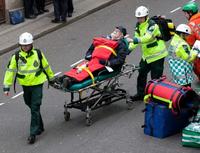-
London holds massive Olympic security drill

Last week, in preparation for the London 2012 Olympic Games, more than 2,500 government officials, local police, and emergency responders participated in a two-day long emergency drill that simulated a terrorist attack on the city’s transportation network
-
-
Anthrax-decontamination foam used in meth lab cleanup
The meth cleanup problem in the United States is a big one; the U.S. Drug Enforcement Administration lists thousands of locations where law enforcement agencies have found chemicals or paraphernalia indicating the presence of either clandestine drug laboratories or dumpsites; Sandia’s decontamination foam, originally developed to deal with anthrax, is now also a meth eraser
-
-
Study finds use of GPS jammers across U.K.
A new study by Chronos Technology reveals that GPS jamming devices are relatively common in the United Kingdom
-
-
Demand for Israeli security solutions remains strong -- and is growing
Homeland Security NewsWire’s executive editor Eugene K. Chow recently spoke with Koby Tanzer, a partner at Indigo Strategic Partners, an investment firm that specializes in the Israeli security and defense sector; in the interview, Tanzer discusses Indigo’s investment philosophy, how the global recession has affected defense and homeland security spending, trends in the global homeland security market, mobile device-based security solutions, and more
-
-
One in three of military aircraft are drones
A report by the Congressional Research Service (CRS) recently made public reveals that unmanned drones now account for 31 percent of all military aircraft
-
-
Surveillance truck helps Fort Lauderdale keep streets safe
Police in Fort Lauderdale, Florida are trying a new approach to fighting crime – blatantly telling criminals they are under surveillance
-
-
Raytheon unveils new law enforcement tech center
Last week Raytheon opened the doors for the first time to its new state of the art law enforcement technology center in Downey, California
-
-
New tracking bracelet helps local police find missing loved ones
With the help of new tracking technology families in Forsyth County, Georgia will no longer have trouble keeping track of their loved ones
-
-
In Keene, N.H., locals oppose military equipment for police
With the help of a $285,933 DHS grant, local police in Keene, New Hampshire were all set to purchase a new armored vehicle until local residents got wind of the plan; the citizens of the quiet New Hampshire town of 23,000, which has only seen two murders since 1999, questioned why police needed such an expensive military-type truck and balked at the militarization of a local force; with federal counterterrorism money continuing to pour into local communities, lawmakers and residents across the country will have to grapple with the same issues as Keene and determine what kind of police force they want to have patrolling the streets
-
-
GovSec Conference focuses on key security challenges

This year’s annual GovSec Security Conference and Expo aims to train the nation’s law enforcement officials on how to tackle the most pressing national security threats facing the United States
-
-
Accenture develops crime management system for Norway
Accenture is developing a new national crime management system for the Norwegian National Police Directorate (POD) to support police investigations and criminal prosecutions in Norway; the crime management system will enable the Norwegian police force to manage, link, and analyze case information and intelligence for more reliability and consistency across law enforcement, police investigations, border management, emergency response, and case administration
-
-
Law enforcement supports N.Y. DNA database expansion
A growing number of New York law enforcement officials have backed Governor Andrew Cuomo’s proposal to expand the state’s DNA Databank
-
-
Statistical model removes barriers to using fingerprint evidence in court
Potentially important fingerprint evidence is currently not being considered in legal proceedings owing to shortcomings in the way it is reported; researchers have devised a statistical model to enable the weight of fingerprint evidence to be quantified, paving the way for its full inclusion in the criminal identification process
-
-
New crime-fighting methods to deter, nab terrorists
The goal of an emerging field in forensics — chemical forensics — is to use the technology of chemistry to trace weaponized toxic substances and related materials back to their source
-
-
Predictive tools help police map crime before it happens
In recent years geographical information systems have becoming increasingly popular with law enforcement agencies, helping to predict crime hotspots, burglaries, and other incidents
-
- All
- Regional
- Water
- Biometrics
- Borders/Immig
- Business
- Cybersecurity
- Detection
- Disasters
- Government
- Infrastructure
- International
- Public health
- Public Safety
- Communication interoperabillity
- Emergency services
- Emergency medical services
- Fire
- First response
- IEDs
- Law Enforcement
- Law Enforcement Technology
- Military technology
- Nonlethal weapons
- Nuclear weapons
- Personal protection equipment
- Police
- Notification /alert systems
- Situational awareness
- Weapons systems
- Sci-Tech
- Sector Reports
- Surveillance
- Transportation
Advertising & Marketing: advertise@newswirepubs.com
Editorial: editor@newswirepubs.com
General: info@newswirepubs.com
2010-2011 © News Wire Publications, LLC News Wire Publications, LLC
220 Old Country Road | Suite 200 | Mineola | New York | 11501
Permissions and Policies
Editorial: editor@newswirepubs.com
General: info@newswirepubs.com
2010-2011 © News Wire Publications, LLC News Wire Publications, LLC
220 Old Country Road | Suite 200 | Mineola | New York | 11501
Permissions and Policies
